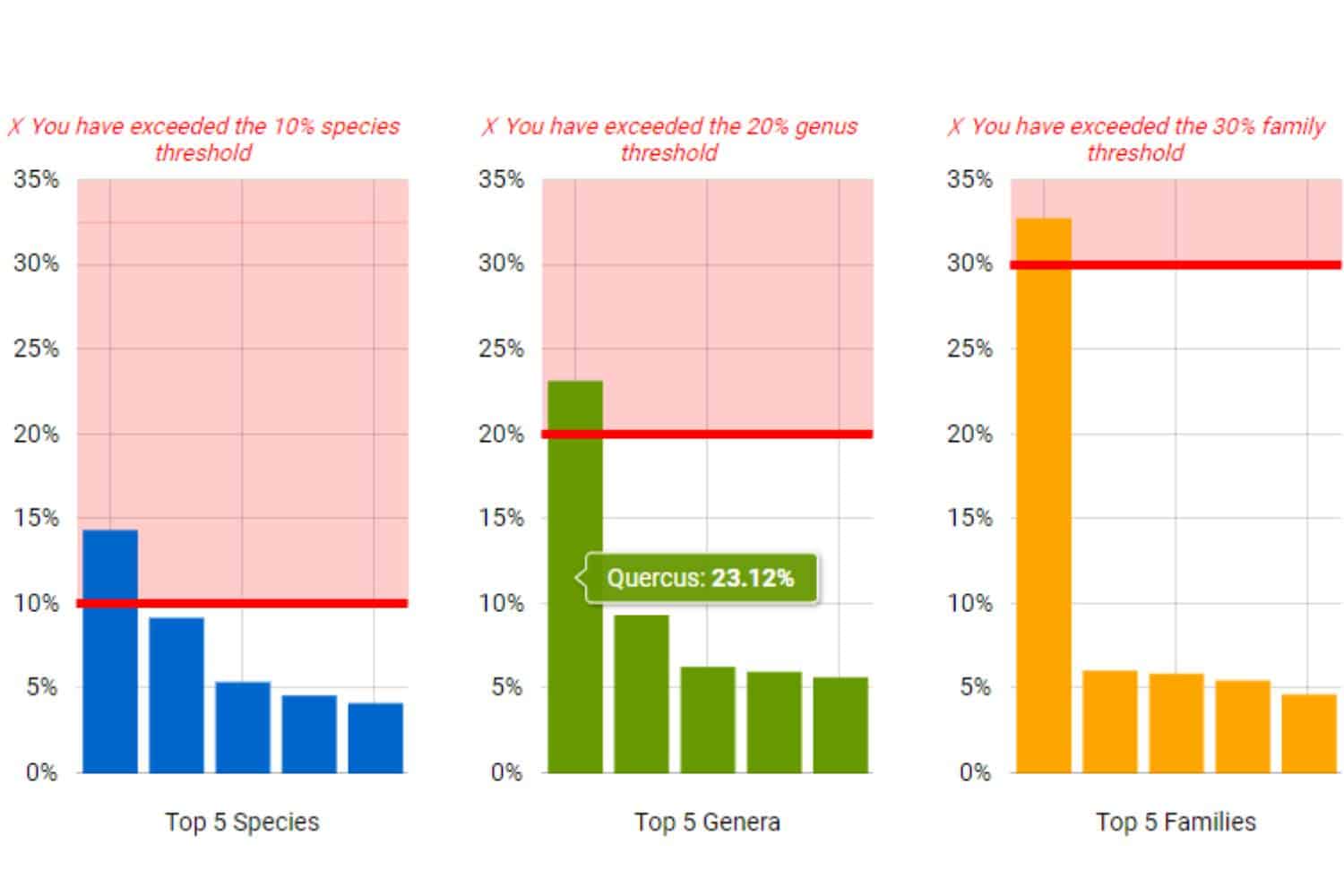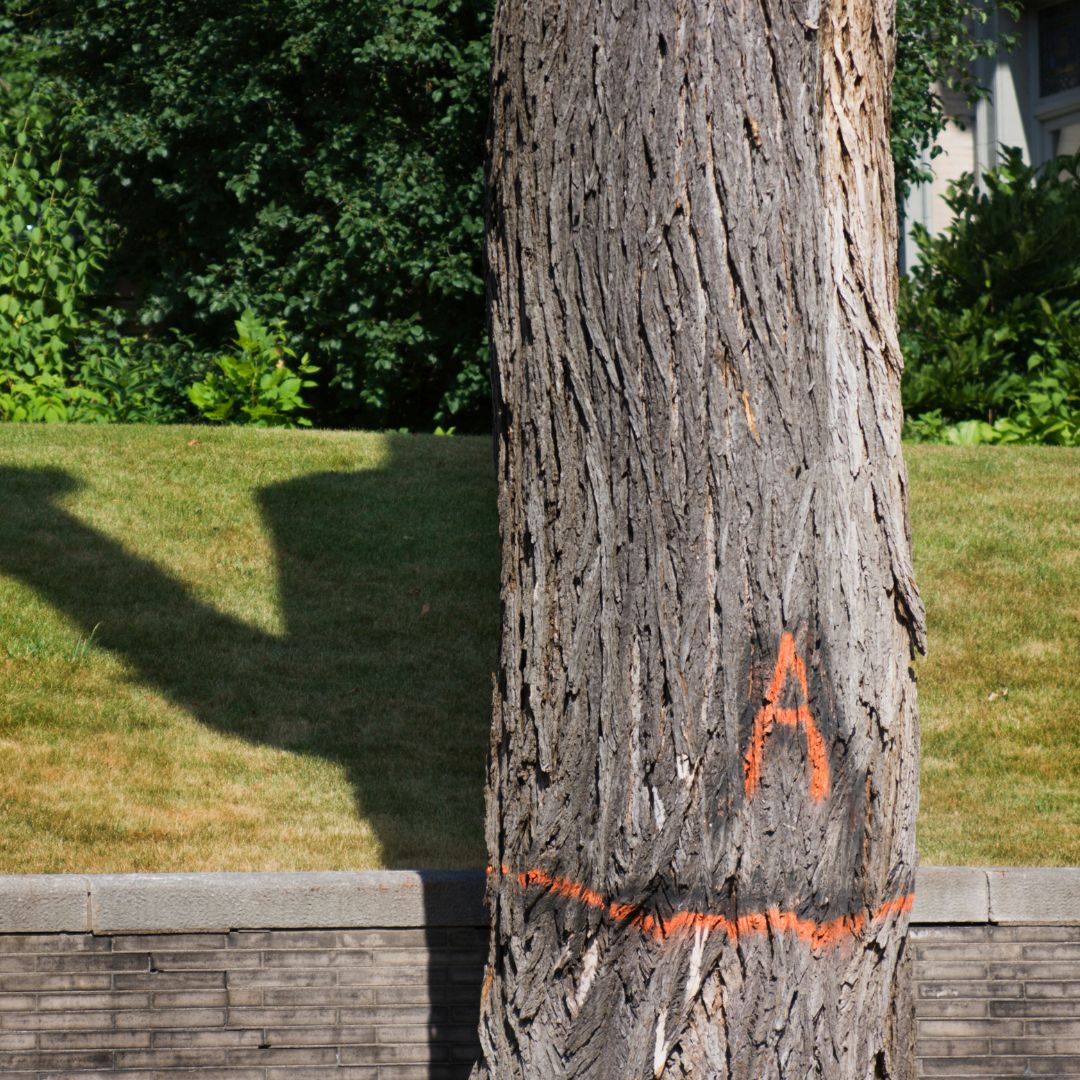The 10-20-30 Rule For Tree Diversity
A look at the long-standing urban forestry rule of thumb
January 24,2024 | Alec Sabatini

An urban forest population should include no more than 10% of any one species, 20% of any one genus, or 30% of any family.
This nicely sequential tree diversity rule has been widely referenced and applied by communities and urban foresters around the world. This diversity goalpost is now also tracked within TreePlotter INVENTORY™. Users can see how their urban forest stacks up to the 10-20-30 rule, along with other composition statistics, within the Tree Management Insights dashboard.
The 10-20-30 tree diversity rule has been around for over 30 years, garnering both praise and criticism. Let’s look at why urban foresters have found value in the guideline, as well as some of the rule’s limitations.
An example of the tree diversity section of the Tree Management Insights dashboard.

Benefits of the 10-20-30 Rule
Dr. Frank Santamour, a Research Geneticist at the US National Arboretum, is credited with the first published reference of the rule. His 1990 paper Trees For Urban Planting: Diversity, Uniformity, And Common Sense notes, “I am not sure who first propounded the “10% rule”, nor am I sure that anyone would want to take credit for it, but it is not a bad idea.”
The urban environment is a harsh place for trees to thrive. When city foresters identify a tree species tolerant of city conditions, that grows quickly, AND offers great aesthetic value, there is a temptation to plant it everywhere. However, going all in on a few species is a high-risk strategy. For the potential consequences, see the cautionary tales of Dutch Elm Disease or Emerald Ash Borer.
The 10-20-30 rule is a way to safeguard against catastrophic losses from future pest and disease threats. If a deadly new tree threat arises, losses are limited and the majority of urban tree canopy is preserved. This protects against a drastic loss of ecosystem services and a municipal budget roller coaster.
A wide urban forestry gene pool also creates a stronger pest defense. A diversity of plant species supports more natural enemy communities and pests have a harder time locating suitable hosts when they are less concentrated. Additionally, diverse urban forests are more resilient to shifting climate conditions, as different species have varied tolerance to heat, drought, excessive rainfall, strong winds, and pollution.
There are compelling benefits to a highly diverse urban forest, but planting that diversity into reality is challenging. Many cities around the world still struggle with lopsided species composition. For some examples, check out the DiversiTREE project, which visualized urban forest diversity for eight cities around the world. No city successfully hits the 10-20-30 mark, but some are much closer than others. There are also stark differences between the tree diversity in city centers versus outer areas, which leads us to one of the rule’s limitations: scale.
Limitations of The 10-20-30 Rule
What scale should the rule be applied to? City boundaries? Neighborhoods? Blocks?
Depending on the scale, an urban forest could be a monoculture or wildly diverse. The city center of Amsterdam is 47% Dutch Elm, while the top species of the surrounding areas is the London Plane tree at only 11%. One suggestion is the “look around you” scale. If you’re preparing a planting, look around and if you already see that tree, plant something else. However, the “one of this, one of that” style may put urban foresters at odds with designers for its lack of aesthetic appeal.
Another proposed limitation is the rule is not restrictive enough. Many diseases and pests, such as emerald ash borer, threaten the entire genus, and having 10% white ash and 10% green ash still means one-fifth of the urban forest is at risk. South Dakota State University’s Dr. John Ball has proposed narrowing the limits: no more than 5% of any one genus.

On the flip side, Professor Norman Richards argued a rule like 10-20-30 would do more harm than good if it means proven-adapted species are replaced by poor-adapted or unproven species for the sake of species equity. “Simple percentage limits on species do not safeguard a population from poor species choices. Ill-adapted species can be a problem at only a few percent of a large street tree population,” writes Richards. Could the benefits gained by heavily planting a long-lived, well-adapted species outweigh the risk of catastrophic loss? Elm trees served cities with benefit-rich, arching canopies for decades before the Dutch Elm Disease decline.
A Target For Moving In The Right Direction
If you google just “10-20-30 rule”, the first 100 results are about presentations. It’s a popular rule for creating a pithy PowerPoint: no more than 10 slides, no longer than 20 minutes, and no less than 30-point font.
This more popular rule nicely demonstrates why, even with its limitations, the 10-20-30 rule for tree diversity remains valuable. It communicates an important concept concisely and memorably. A high visibility guideline like the 10-20-30 rule helps create awareness and motivation to keep tree diversity top of mind for urban forestry professionals. As long as communities still struggle with lopsided species composition, there is value in shifting the status quo with the 10-20-30 rule.
By no means is 10-20-30 the be-all and end-all of urban forest diversity, but it is a helpful compass for planning your next tree planting. Captain Barbossa, in Pirates of the Caribbean: Curse of the Black Pearl, says it best:
Tree species are only one component of urban forest diversity. Variety in sizes, ages, shapes, bloom times, and leaf colors, also contribute to the benefits, resilience, and aesthetics of urban forests.
If you are interested in tracking and improving the diversity of your community’s forest we have software solutions and expert services to assist at any step in the process. Get in touch to have a conversation about your urban forest goals.
Related Resources

How To Set Effective, Evidence-Based Urban Tree Canopy Goals
Urban tree canopy goals must walk a careful line of ambition, inspiration, and practicality. To encourage well-informed canopy cover goals we have assembled some best practices to help communities find the right target for them.

Creating the Right Change With Urban Forestry Funding
The federal government is contributing 1.5 billion …with a B… to urban forests, and states, cities, and the private sector are heaping on additional contributions too. Not to look this gift horse in the mouth, but urban foresters have advocated for better urban forestry funding for years. What changed?

Get Your Urban Tree Canopy Assessment TOMORROW
We are the first in our industry to provide 60-cm resolution land cover data built into an interactive tree canopy software tool, making it simple for you to view, plan and achieve your tree canopy goals. Off-the-shelf tree canopy analysis for the lower 48 is already completed.

How Longview, Washington Uses Tree Canopy Data
Longview’s urban forest is approaching a tipping point. As a planned city, street trees were planted en masse during the town’s construction and now many of those ancient trees are in decline. Longview’s Parks Department is taking a proactive stance toward these looming changes by tracking its trees from the bottom up AND the top down.
Stay Up To Date With The Latest News and Events
Join Our Community
Stay informed on the urban forestry industry with our monthly TREEbune newsletter, live webinars, and industry-specific content delivered to your inbox.
Urban Forestry Webinars
PlanIT Geo has a substantial on-demand webinar library. Get CEU credits, grow your knowledge base, and stay current on cutting edge industry technology.
Follow Us
We love to share industry-related news, software tutorials, blogs, and company news across our social channels.
Stay Up To Date With The Latest News and Events
Join Our Newsletter
Stay informed on the urban forestry industry with our monthly TREEbune newsletter, live webinars, and industry-specific content delivered to your inbox.
Urban Forestry Webinars
PlanIT Geo has a substantial on-demand webinar library. Get CEU credits, grow your knowledge base, and stay current on cutting edge industry technology.
Follow Us
We love to share industry-related news, software tutorials, blogs, and company news across our social channels.
